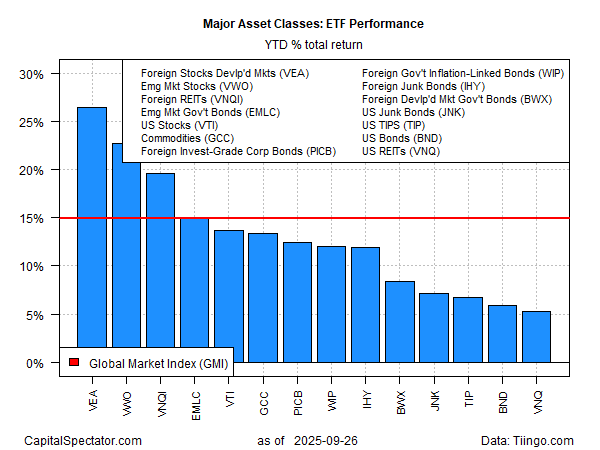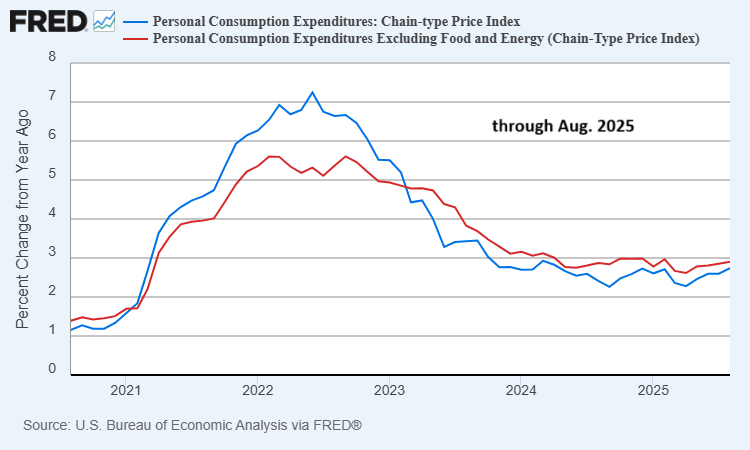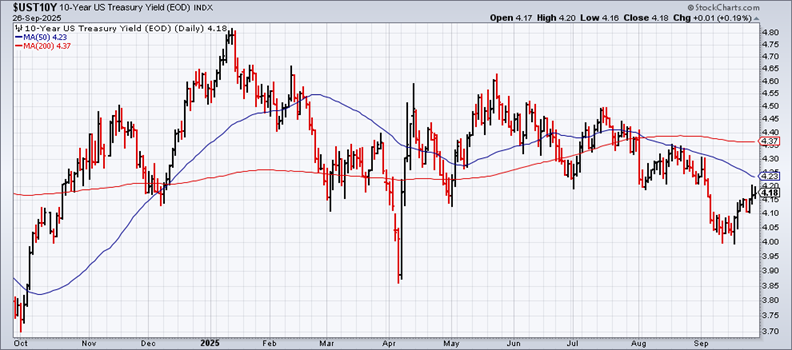S&P 500 shrugs off hawkish Fed minutes as focus shifts to Nvidia earnings
Pick an asset allocation. Any allocation. All the possibilities have been winning combinations so far in 2025. As a result, the most striking aspect of global markets as the third quarter winds down: across-the-board gains continue to prevail for the major asset classes, based on a set of ETFs through Friday’s close (Sep. 26).
Leading the rally: foreign equities in developed markets ex-US (VEA), posting a strong 26.4% year-to-date gain. In second place: stocks in emerging markets (VWO), which are up nearly 23% in 2025. US shares (VTI), by comparison, are a middling performer with a 13.6% rise this year.

Both of the foreign equity funds, along with offshore property (VNQI), are outperforming the Global Market Index (GMI), which is having a very good year of its own. GMI is an unmanaged benchmark (maintained by CapitalSpectator.com) that holds all the major asset classes (except cash) in market-value weights via ETFs and represents a competitive benchmark for multi-asset-class portfolios.
The laggard this year: US real estate investment trusts ({40699|VNQ}}); the fund is posting a relatively modest 5.2% total return for 2025.
If the final print for this year’s performance ended here, the overall results would compare favorably with the historical record. Cue up the outlook for Q4, however, and things start to look complicated.
The immediate question: Will animal spirits be tested this week as the US government grapples with the possibility of a shutdown starting Oct. 1? President Trump is scheduled to meet with Congressional leaders today to keep Washington open.
Meanwhile, the crowd is still trying to figure out if tariff-related inflation is a risk. Hanging in the balance: the bullish aura of late that springs from expectations that the Federal Reserve will continue to cut interest rates, as it did on Sep. 17.
Fed funds futures are still pricing in high odds that the central bank will ease policy again at the next FOMC meeting on Oct. 29.
The outlook, however, may be more complicated than the futures market suggests. Notably, the Fed’s preferred measure of inflation – the personal consumption expenditures (PCE) price index – rose in August to 2.7% year on year, the highest since April 2024. Core PCE inflation was steady, albeit at a higher 2.9% pace.

Is this a sign that tariff-related inflation is starting to spill over into the wider economy? There’s still room for debate, which is why the September consumer price index report in a few weeks will be a high-stakes release to watch.
For now, markets are trading on the basis that any pickup in inflation will be mild and brief. For a real-time gauge that confirms or denies that assumption, the US 10-year Treasury yield deserves close attention this week and beyond.
The benchmark rate is up 14 basis points since the central bank reduced its target rate. That’s a trivial change, and so the pop could be noise. On the other hand, if the yield continues to trend up, it’s going to get harder to dismiss the bond market’s apparent concerns about the inflation outlook.
